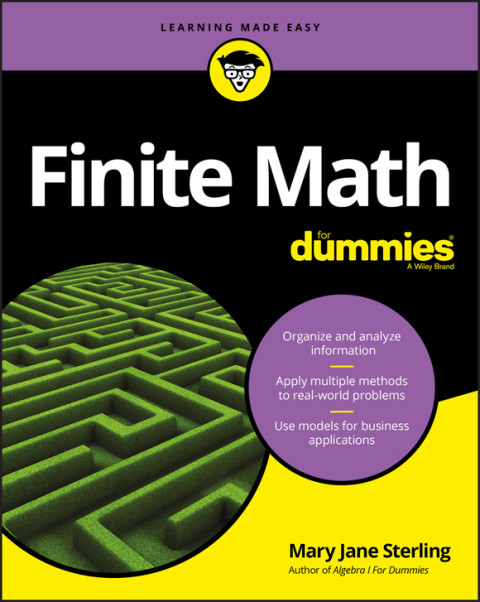Description
Efnisyfirlit
- Cover
- Introduction
- About This Book
- Foolish Assumptions
- Icons Used in This Book
- Beyond the Book
- Where to Go from Here
- Part 1: Getting Started with Finite Math
- Chapter 1: Feeling Fine with Finite Math
- Getting in Line with Linear Statements
- Making the Most with Matrices
- Staying with the Program
- Getting Set with Sets
- Posing the Probability
- Figuring in Financial Factors
- Finding Statistical Satisfaction
- Considering the Logical Side of Mathematics
- Unlocking the Chains
- Getting into Gaming
- Chapter 2: Lining Up Linear Functions
- Recognizing Equations of Lines
- Graphing Lines on the Coordinate Plane
- Determining Relationships between Lines
- Solving for a Variable
- Chapter 3: Solving Systems of Linear Equations
- Solving Systems Using Elimination
- Solving Systems Using Substitution
- Dealing with Too Many or No Solutions
- Making Linear Equations Work for You
- Chapter 4: Taking on Systems of Inequalities
- Ruling with Inequalities
- Graphing Linear Inequalities
- Part 2: Making Use of Available Methods
- Chapter 5: Making Way for Matrices
- Squaring Off with Matrix Basics
- Investigating Row Operations
- Applying Matrices and Their Operations
- Chapter 6: Making Matrices Work for You
- Solving Systems of Equations Using Matrices
- Discovering Multiple Solutions
- Applying Matrices to Tasks
- Taking Advantage of Special Formulas
- Chapter 7: Getting Lined Up with Linear Programming
- Setting Up Linear Programming Problems
- Going Three-Dimensional
- Chapter 8: Simply the Simplex Method
- Delineating Simplex Method Steps for Maximization
- Making the Most of Minimization
- Part 3: Using Finite Math to Tackle World Situations
- Chapter 9: Setting Up Sets
- Introducing Set Notation
- Performing Basic Operations
- Using Venn Diagrams for Better Views
- Chapter 10: Processing the Probability
- Introducing Counting Methods
- Determining the Probability of an Event
- Applying Probability Techniques
- Chapter 11: Counting on the Mathematics of Finance
- Considering Simple Interest
- Compounding Things with Compound Interest
- Analyzing Annuities
- Amortization
- Chapter 12: Telling the Truth with Statistics
- Presenting Data Graphically
- Measures of Central Tendency
- Variance and Standard Deviation
- Investigating the Normal Distribution
- Chapter 13: Logic
- Logically Presenting the Vocabulary
- Finding the Truth with Truth Tables
- Equivalent Statements
- Studying the Conditional
- Analyzing Arguments
- Applying Logic to Circuits
- Part 4: Employing the Tools of Finite Math to Expand and Investigate
- Chapter 14: Markov Chains
- Recognizing a Markov Chain
- Coming to Terms with Markov Chains
- Working with Transition Matrices
- Probability Vectors
- Absorbing Chains
- Making Long-Term Predictions
- Chapter 15: Playing Games with Game Theory
- Playing Fairly
- Playing by the Rules
- Getting Strategic
- Yielding to Domination
- Determining the Moves
- Chapter 16: Applications of Matrices and Game Theory
- Traffic Flow
- Battle of the Bismarck Sea
- The Game of Chicken
- The Prisoner’s Dilemma
- The Traveler’s Dilemma
- Blotto’s Rules
- Jack Be Nimble
- Part 5: The Part of Tens
- Chapter 17: Ten Financial Formulas
- The Rule of 72
- Leverage Ratio
- Gains and Losses
- Determining Depreciation
- Total Return on Investments
- Expected Return
- Inflation-Adjusted Return
- Remaining Balance
- Future Value of Annuity Due
- Bond Pricing Formula
- Chapter 18: Ten Important Graphing Calculator Functions
- Graphing Lines for Intersections
- Adjusting the Window
- Entering Matrices
- Adding, Subtracting, and Multiplying Matrices
- Powering Up Matrices
- Finding Matrix Inverses
- Solving Systems of Equations Using Matrices
- Decimals to Fractions
- Counting with Permutations and Combinations
- Making Statistical Statements
- Glossary
- About the Author
- Advertisement Page
- Connect with Dummies
- Index
- End User License Agreement






Reviews
There are no reviews yet.